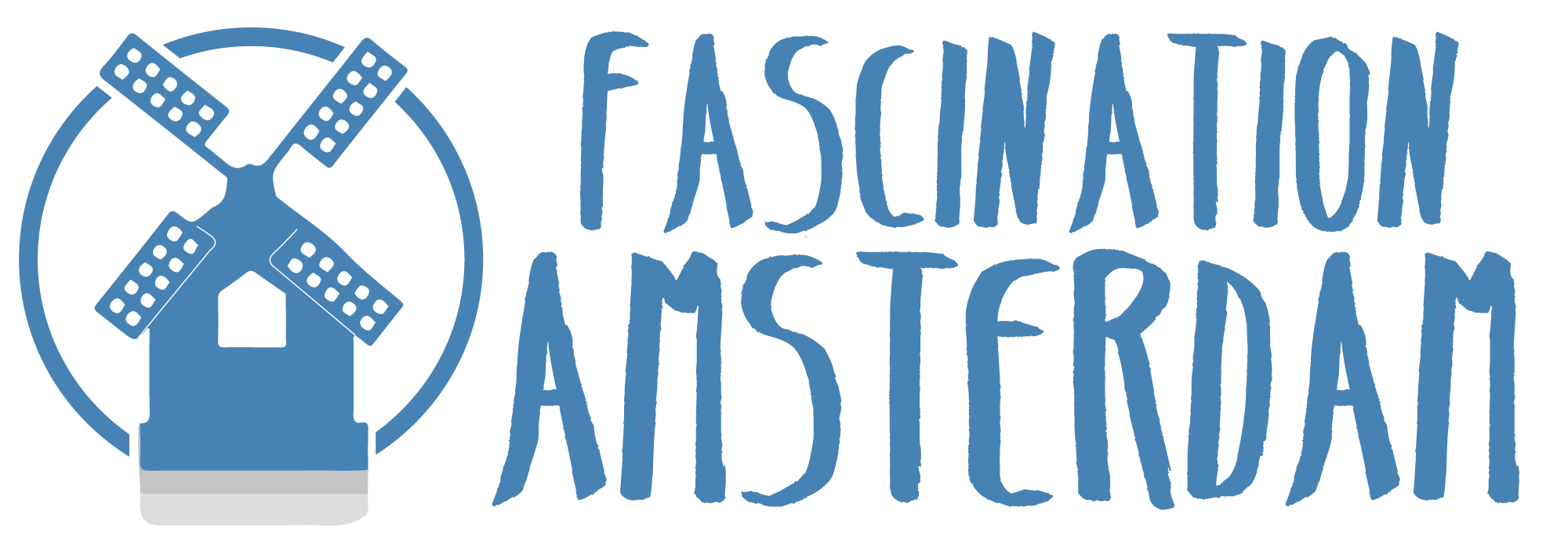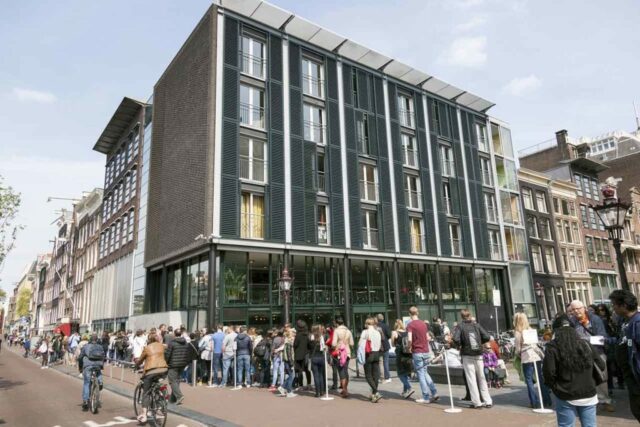Anne Frank Haus – The Anne Frank House in Amsterdam was renovated for two years, until November 2018. The museum is now trying to cope better with the large number of visitors and appeal to younger people with a modern exhibition concept. The background and context of Anne Frank’s life story are now more in the foreground. Lots of information on this and everything about visiting the museum can now be found here in my blog.
Please read this article to get an overview of the Anne Frank House and how to visit it. Everything you need to know about buying tickets, admission prices, and opening hours of the Anne Frank Museum can be found at the end of the text or in detail on the separate pages of Anne Frank House admission prices and opening hours.
Who was Anne Frank?
I don’t want to have lived in vain like most people. I want to be useful or bring enjoyment to all people, even those I’ve never met. I want to go on living even after my death!
Because Anne Frank was Jewish, she had to go into hiding in the middle of Nazi Germany in 1942. Anne Frank wrote down her thoughts in her hiding place. Until the hiding place was discovered two years later, and she was deported to a concentration camp.
Shortly before the end of the war, Anne Frank succumbs to typhus and dies. Her father, however, survived the ordeal and published her diary after the war. To this day, Anne Frank is considered one of the best-known contemporary witnesses of National Socialism. The words she wrote down still send shivers down the spine today.
The Anne Frank diaries have long been world-famous and testify to the darkest and coldest abominations of German history.
The Anne Frank House
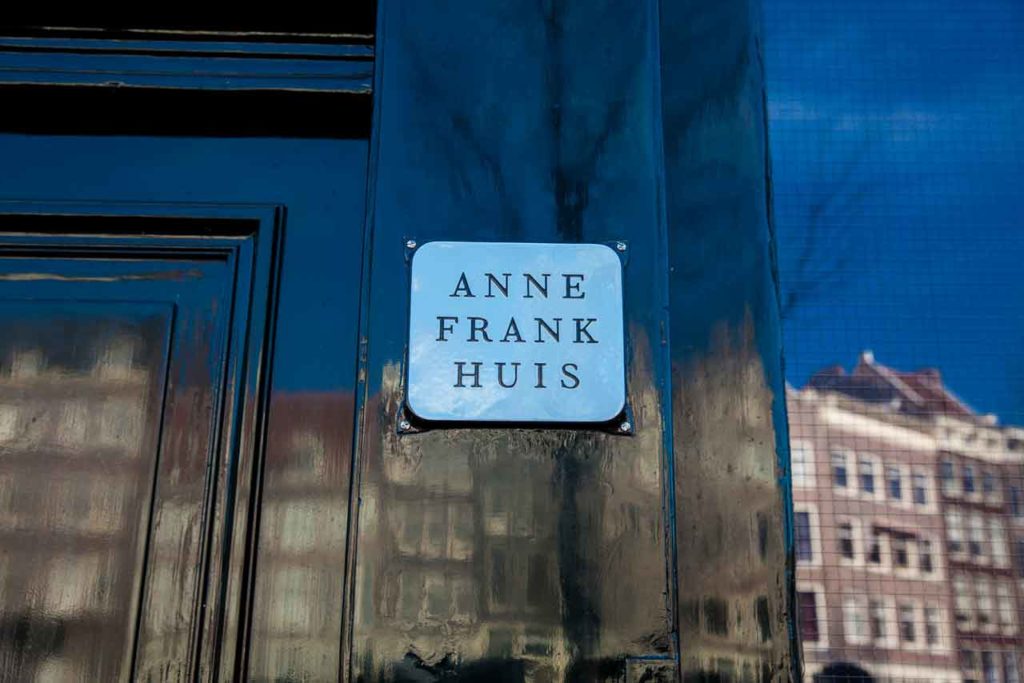
The small rear building at Prinsengracht 263 in Amsterdam, where the Frank family hid for two years, dates back to around 1739 and is now one of the most famous houses in the world. When the house was converted, and a room was added at street level, it was suitable for use as a workshop or warehouse, making it ideal for Otto Frank. He saw it as the perfect place for his company, Pectacon. When Anne Frank’s sister was conscripted to work in a German camp in 1942, the family decided to go into hiding.
The second and third floors of the rear building seem well suited for this, as they are only accessible through a secret entrance behind a bookcase. Even the owner, the Pieron family, is unaware of the fate behind the bookcase and sells the building to a new owner in 1943.
A year later, the fears are realized. The Secret Annex is discovered, and seven members of the family perish in concentration camps. Only Otto Frank survived. The house was to be demolished at the war’s end, but there was resistance. The story of Anne Frank became better known, and many people resisted the demolition with success. In 1960, the house was renovated and opened as a museum. To this day, millions of people make a pilgrimage to the museum and follow in the footsteps of the Frank family at the original site of their tragic fate.
History of the Frank family
The family history goes back to the year 1462. At that time, around 110 Jews from the city of Frankfurt were placed in a separate Judengasse and excluded from Christian holidays with closed gates, for example. In the following years, the number of Jews living there grew considerably – up to 3,000 people in just one alley. Among them were the direct ancestors of Anne Frank, the Cahn family, and the Stern family. Otto Frank, Anne Frank’s father, later emerged from this constellation.
The family attaches great importance to education, rules, and discipline and gradually moves up the ladder. When Otto’s father dies, Otto and his younger brother take over the bank – a family business. During the First World War, the two volunteered for service because they felt like Germans. Otto becomes an officer in the military in France, and his mother and sister also volunteer to work in a military hospital. The family loses a lot of money and prosperity in the aftermath of the war, reparations, and the associated economic crisis.
The social situation towards people of Jewish descent also worsened and caused the family to increase concern. When Hitler came to power, Otto Frank moved to Amsterdam in 1933 and set up his Opekta company there. A year later, he brings his wife and their then-five-year-old daughter Anne. But the hatred of Jews followed them.
In 1940, the German Wehrmacht occupied the Netherlands and enacted harsh laws against Jews here too. When Anne’s sister was ordered in writing to get ready for deportation to a German camp, Otto took the family to the back building of his company. He had been preparing this for years. In 1944, the family was betrayed by the Gestapo and taken to Auschwitz on the very last transport before the end of the war. From there, they were sent to Bergen-Belsen.
With 200,000 people, the camp has long exceeded its capacity, and Anne and her sister fall victim to a typhus epidemic. The rest of the family also died. Only Otto Frank was rescued by Soviet troops in 1945.
Even after many decades, there is still significant interest in the fate of Anne Frank and her family. Many guided tours, which do not include access to Anne Frank, provide an insight into Amsterdam during the Second World War.
💡 Tip: Anne Frank tour or the tour through the Jewish quarter
The Anne Frank & Second World War tour could also be worthwhile for small groups.
The museum
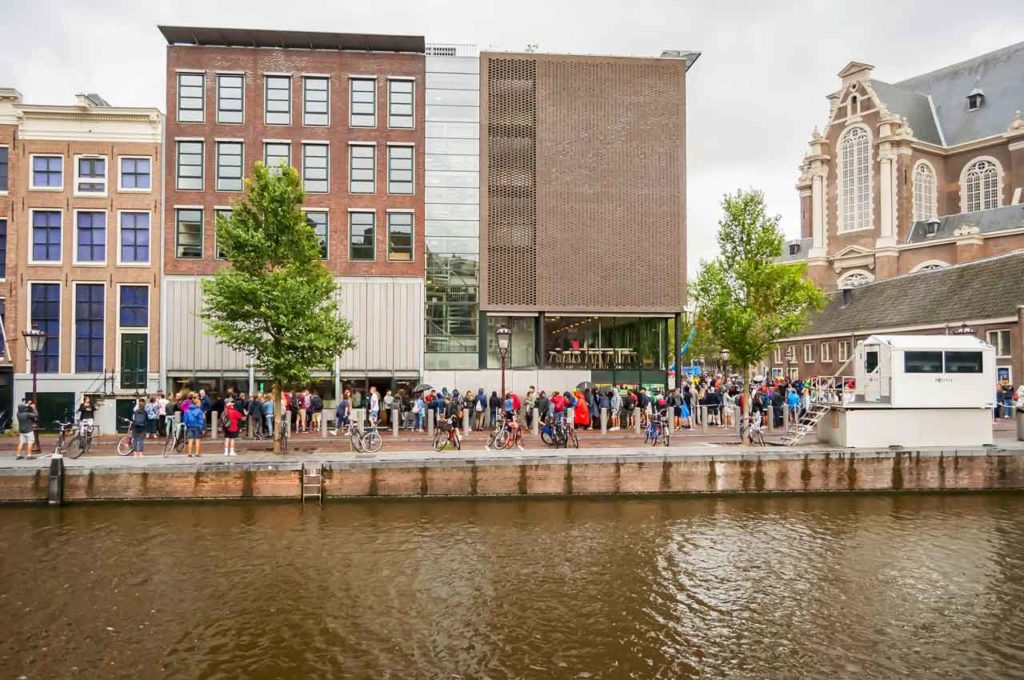
In 1960, the house where Anne Frank and her family hid was converted into a museum, renovated, and extended several times. At Otto Frank’s request, the rooms of the hiding place do not contain any furniture. However, the family’s original remains can still be seen, which sends a shiver down the spine. The lines on the wallpaper with which Otto recorded the height of his two daughters can still be seen today.
The museum also contains the diaries and various aspects of the Holocaust and racial hatred. In 2007, over one million people from all over the world visited the House of Anne Frank. The museum can easily be reached from the central train station by bus or streetcar. The Westermarkt stop is nearby. Bus lines 170, 172, and 174, and streetcars 13, 14, and 17, go there.
Museum tickets
Buying tickets proves to be difficult due to the constantly high demand. Online tickets are usually completely sold out many weeks and days in advance.
| Anne Frank Haus | Price* | Online-Ticket |
|---|---|---|
| Adults | 16.00 € | Official website |
| 10-17 years | 7.00 € | Official website |
| 0-9 years | 1.00 € | Official website |
| ✅ Bestseller Walking Tour | 32.50 € | Book Online |
🎟️ Online ticket sales start every first Tuesday of the month for the following six weeks.
Tickets will not be sold on-site.
ℹ️ In my article, you can find everything about the Anne Frank House – tickets and admission prices.
Practical information
The Anne Frank House is located in the centre of Amsterdam at Prinsengracht 263-267. The museum entrance and official address are Westermarkt 20, 1016 DK Amsterdam; telephone +31 20 556 71 05
The museum offers an extensive program for school classes and groups. There is also a direct link to the Anne Frank House website under Visiting Classes and Groups.
Detailed information for all practical questions can be found on a separate museum website. In addition to the general visiting rules, this includes accessibility for people with disabilities, a checkroom, free audio guides, a museum store, a museum café, and everything about photography.
Opening Hours
The Anne Frank House is open to the public all year round. The only day we close is Yom Kippur (24 September 2023). On various days, there may be deviations from the above opening hours.
| Date | Time of day |
|---|---|
| August 27 | 13:00 till 22:00 |
| October 5 | closed, Yom Kippur |
| December 25 and 31 | 9:00 till 17:00 |
Please see my separate page on the Anne Frank House opening hours for the exact dates, times, and possible variations.
Place of silence
To enter the museum is to enter one of the darkest chapters in human history. It is a confrontation with the atrocities of which humanity has been capable. Visitors to the museum speak of eerie rooms, oppressive silence, and the odd tear that still runs down the cheek at the sight of the young and brave Anne Frank and her lion father, Otto.
There is no doubt that a visit to the museum in the Anne Frank House will leave a lasting impression on you.
Jewish Museum Amsterdam
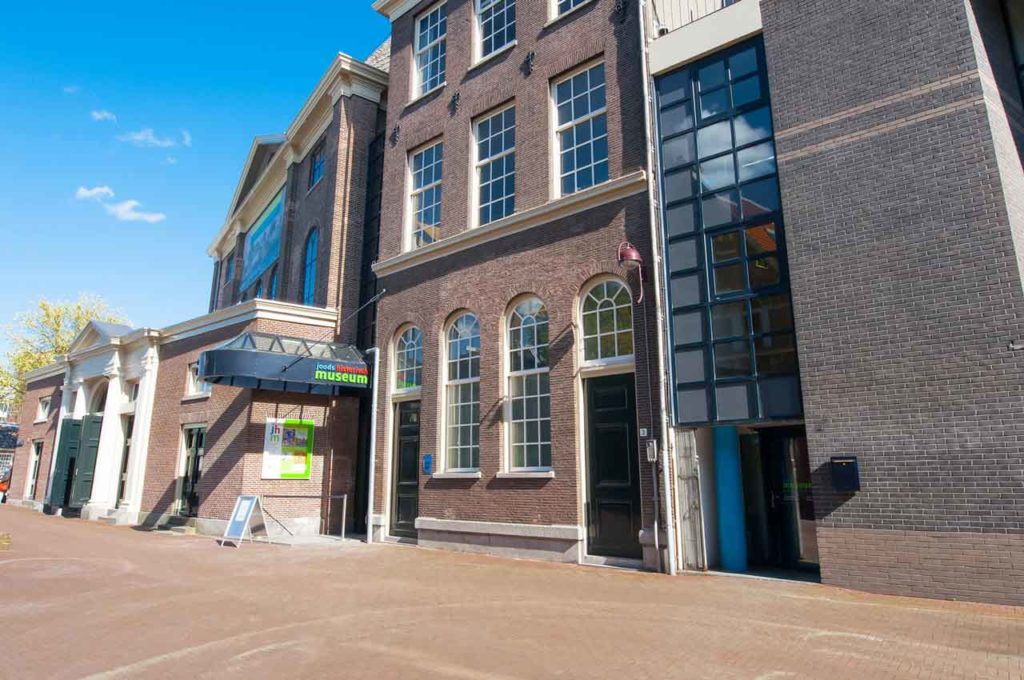
There is another well-known Jewish museum in Amsterdam. It is located in the city’s former largest synagogue and has existed since 1987. Its predecessor was the Stichting Joods Historisch Museum. It was opened in February 1932 and closed during the German occupation of the Netherlands with the new anti-Jewish laws. Much of the exhibition and collection was looted by the Nazis.
Only a tiny part of it has been recovered. After the Second World War, the museum reopened in 1955. Since then, the murder of the Dutch Jews, the flight of many Jews to the Netherlands, and the crimes of the Nazis have been an essential part of the museum’s exhibitions and work. Queues are much shorter than at the Anne Frank House. Tickets for the Jewish Museum Amsterdam are also available here.
The museum is easy to reach by public transport. Subway lines 51, 53, and 54 stop at Waterlooplein. This is where the Jewish Museum is located. Trams 9 and 14 also stop here. The exact address is Nieuwe Amstelstraat 1, 1011 PL Amsterdam. A nearby car park is called P Het Muziektheater, Waterlooplein 28, 1011 PG Amsterdam, a 2-minute walk from the museum.
Sehenswert ist auch die direkt neben dem Museum gelegene Portugiesische Synagoge aus dem 17. Jahrhundert, erbaut von der Amsterdamer Gemeinde der Juden portugiesischer und spanischer Abstammung. Vor allem eine hölzerne Bundeslade und beeindruckende Leuchter gehören zum viel beachteten Inventar und ziehen zahlreiche Besucher an.
The 17th-century Portuguese Synagogue, built by Amsterdam’s community of Jews of Portuguese and Spanish descent, is also worth a visit. The wooden Ark of the Covenant and the impressive candelabra are among the most notable features and attract many visitors.
History tour
If you didn’t get a ticket for the Anne Frank Museum or want to know more about the Second World War in Amsterdam and the life of the Jewish population at that time, you can join a 2-hour Anne Frank history tour.
However, the tour does not include admission to the Anne Frank Museum. This exciting tour can be found on the provider’s website.
| Anne Frank 2-hour history tour | Price* | Online-Ticket |
|---|---|---|
| Anne Frank and Second World War | 28.50 € | Book Online |
| Anne Frank tour | 55.00 € | Book Online |
*Prices are variable. The current price of the provider always applies.
You can find more suggestions for tours around the Anne Frank House in my additional articles on Anne Frank House opening hours and admission prices.
